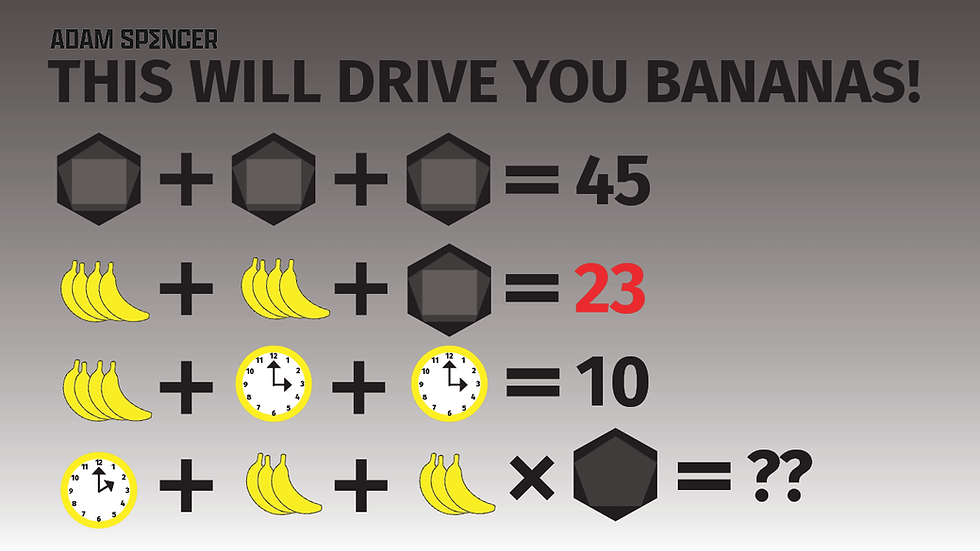Number 23: The birthday paradox of probability
- Adam Spencer
- Jun 19, 2024
- 3 min read
How many people in a group do you need to have before the probability of a shared birthday amongst them? Plus I explain why it’s not a continuous summer – or winter, autumn of spring for that matter – anywhere on Earth.
Birthday brain buster

Do you agree it’s unlikely that two randomly chosen people will share a birthday? What about three people? Still unlikely. Four? Five?
But if we had a group of 330 people, you would probably agree that somewhere within that group there is likely to be a pair of people who celebrate the same birthday.
So how large does the group have to be before it is more likely than not to contain a shared birthday?
Take some time to consider this. Over my years of asking thousands of people this question, the answers seem to average out around 80-100 people.
Stunningly … it is only 23!!!
Yep, a group of 22 people has about a 48% chance of a shared birthday. A group of 23 has a 51% chance!
This gloriously counterintuitive result is called the 'birthday paradox' and is very close to my favourite piece of ‘recreational’ mathematics.
The maths behind it is actually easy to follow and featured in my Big Book of Numbers - however you can check out a free PDF version here.
Brrr… Why do the seasons change?

Astronomers believe that around 4.5 billion years ago, the Earth collided with a Mars-sized planet called Theia. This occurred some 50-100 million years after Earth’s formation. It’s thought the impact created a giant dust cloud which eventually formed into the moon. This and other ancient impacts probably gave the Earth its tilt.
You see, as the Earth travels around the Sun, it also rotates about its axis (an imaginary line from the North to South Pole through the Earth’s centre). But the axis of the Earth is actually tilted 23.5°, which is why the Earth has seasons. And if there was no tilt, the hottest and coldest times of the year would be the same for both hemispheres.
As opposed to Uranus which is tilted at 93°; that’s right Uranus doesn’t spin through space … it rolls!
Fascinating fast facts about 23!

That’s gotta hurt
Nicolaus of Damascus’s detailed account of the assassination of Roman Emperor Julius Caesar claims he was stabbed 23 times. Given that there were 60-or-so reported conspirators, it could have been worse, I suppose. Of the 23 stab wounds, Suetonius (writing 150 years later ... so take it with a grain of salt) reckoned that only one was fatal – the second to his chest which pierced his aorta.

Bling Bling!!!
Grading diamonds by colour involves a 23-step scale developed by the Gemological Institute of America. Starting at Z for light yellow or brown diamonds, it works up to D for the most colourless, rare and valuable rocks. Why stop at D for the best ones? Many prior grading systems used As, Bs and Cs, so the new scale had to avoid confusion with these.

Don’t taunt the bull!
Basketball great Michael Jordan made jersey #23 famous. Returning from his first retirement, he wore 45 suggesting the story would continue: 2-3-4-5. After an early loss, Orlando Magic’s Nick Anderson famously said “Number 45 doesn’t explode like number 23 used to. Number 45 is not number 23.” Jordan promptly switched back to #23 and went on to win another three championships!
TRIVIA: Win an Adam Spencer maths book!

The number 23 featured in this brain buster that flew across the internet recently with the claim that only 1% of people could solve it. I’ve got no idea if that’s true, but I will send a signed copy of my book to three (3) randomly chosen readers who correctly answer the puzzle. Send your answer via email here by Saturday 22nd June, 5pm AEST.

That’s all from me for now. If you'd like more geeky fun, please check out my other newsletters below, or connect with me on LinkedIn and X.
Yours in numbers,
Adam
Jump back to: Birthday Paradox Seasons Rome Diamonds Michael Jordan Trivia

Comments